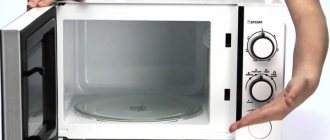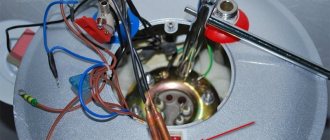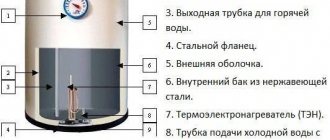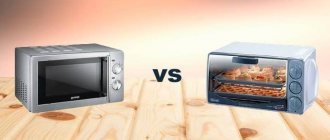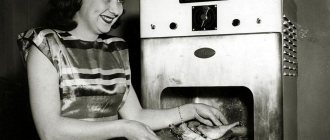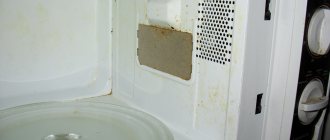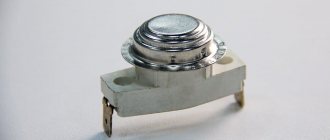It is difficult to imagine modern life without a microwave oven. If the equipment suddenly breaks down, then a slight panic begins, morning delays due to a long breakfast, and even the usual diet changes.
The most common problem is that the microwave works, but does not heat. There can be many reasons - from trivial improper operation to serious breakdowns. Let's figure out what to do in each specific case and how to fix the equipment.
Why doesn't the microwave heat up?
The most common reasons for equipment failure to perform its direct functions are quite banal and are based on improper operation of the microwave. Several points can be highlighted here:
- heating dishes together with metal objects;
- heating dishes in unsuitable containers - for example, with a gold rim or a tight lid;
- cheap and low-quality equipment - manufacturers specifically make it so that it is easier and cheaper to buy a new unit than to repair an old one;
- wear and tear of parts over time.
The microwave does not heat well, does not heat at all, or heats “every once in a while”
1. If the voltage in the network is less than 210 Volts, the power of microwave radiation is reduced. This is especially true for summer cottages and rural areas. Due to the reduced voltage, it takes several times longer to heat up, or the microwave heats up “every time”. 2. The malfunction may be related to the control circuit - timer or control unit. 3. The malfunction may be related to power circuits - high-voltage transformer, high-voltage fuse, high-voltage diode, capacitor or magnetron. 4. In inverter microwave ovens, the malfunction may be due to the failure of the inverter.
Diagnostics and troubleshooting:
1. Check the voltage in the electrical network. When the voltage drops below 215 Volts, the microwave oven weakly heats the food; when the voltage returns to normal, the microwave oven will work as before.
2. If the voltage is normal, then it’s time to replace the magnetron with a new one.
What to do to avoid Magnetron failure? The causes of magnetron failure most often occur if:
- During operation, the oven chamber was empty, without products, sparking occurs, which leads to damage to the magnetron.
- There was a metal object inside the oven while the oven was operating.
- Natural wear of the magnetron, loss of emission.
Read also: Cyclone filter from sewer pipe
The principle of operation and design of a microwave oven
To understand why the microwave stopped heating and how to fix it, you need to understand the design of the equipment.
Microwaves, namely high-frequency radiation that heats food, are created by a magnetron. It is connected to the camera by a rectangular waveguide, which, in turn, can be covered with a mica plate or a plastic cover.
The power supply is provided by a transformer, which is assisted by a multiplier consisting of a diode bridge and a capacitor. The fuse protects equipment from overloads and short circuits. The fan cools the magnetron and drives warm air into the chamber, which speeds up the heating of the dish.
You can set the mode and time for heating food on the control panel. It can be either mechanical or sensory.
The simplest causes of problems and tips for eliminating them
Microwave oven spins but doesn't heat food? In addition to the lack of heating, pay attention to additional signs - for example, the microwave is humming or making a lot of noise.
First of all, you should look at the instructions, since they contain tips that can help you understand the reasons for the malfunction of the equipment. But the main problems are similar, so we will analyze them. Let's start with the simplest breakdowns that can be fixed at home.
Insufficient voltage
The required voltage in the network for proper operation of the microwave is 220 V. If this figure is lower even by 5-10 V, then the equipment will heat poorly, weakly, or every once in a while - depending on the voltage value. To prevent such surges, it is necessary to install a voltage stabilizer.
Another option in which a lack of voltage may occur is to connect large household appliances such as a refrigerator or washing machine to the same outlet, or even use a double/tee. Such actions are unacceptable, since the microwave oven must have its own free outlet.
Technical difficulites
It happens that the problem is not in the microwave oven itself, but, for example, in the wire or socket. To make sure that this is exactly the problem, you just need to connect the equipment to another outlet and carefully inspect the cord. If problems are found, either the outlet or the cord will need to be replaced.
Door
The microwave is designed in such a way that it will never turn on when the door is open. This is facilitated by special latches on the doors. If they are broken or simply do not fit tightly, then the microwave may not heat the food as well or may not heat the food at all. In this case, there are only two options - change only the latches, or the entire door.
Wrong mode
The reason that the heating in the microwave does not work may be due to ordinary human carelessness. This happens if the previous action of the microwave was defrosting, and then they forgot to turn off or change the function. In this mode, food will never warm up. All that is required in this case is to set the heating mode and, if necessary, increase the power.
If all of the above points have been checked, but the microwave still does not heat food or does it poorly and for a long time, then, most likely, a really serious breakdown has occurred, which is not always possible to fix without a professional.
Do-it-yourself microwave oven repair for more serious problems
There may be several reasons why the microwave has stopped heating. Most often these are problems:
- control unit (timer malfunction);
- power network;
- fuse (a sudden surge in voltage can damage it);
- capacitor;
- high voltage diode;
- magnetron (the most expensive part of a microwave oven).
Now let’s try to figure out in detail how it is possible to eliminate such breakdowns - how to fix a microwave oven with your own hands.
Repairing a microwave oven with your own hands is possible, but requires care and precision
Do-it-yourself microwave oven repair if the control unit fails and the timer malfunctions
First, unplug the microwave oven, unscrew the screws on the back, and remove the protective cover. Next, we carefully inspect the control board for burnout of conductive paths, swelling, and burnout of elements. It happens that a microwave begins to take on a life of its own – it can spontaneously turn on, turn off, or refuse to work. Here the problem may be a faulty touchpad. In any case, although such parts can be restored, they will not work for long. It is much more cost-effective to purchase a new unit or keyboard, installing them in place of the old ones.
IMPORTANT!
When purchasing replacement parts, choose those marked with the same markings as those previously installed. This way you will save yourself from unnecessary costs. By the way, such purchases cannot be returned or exchanged.
Repair of the control unit - soldering of jumpers to replace burnt tracks
The microwave works, but stopped heating due to problems in the power circuit
This happens quite often. The first step is to check the magnetron circuit fuse (high voltage). If it burns out, the backlight of the microwave oven and the rotation of the platform remain in working order, and power is not supplied to the magnetron (microwave gun). This can be treated by replacing the high-voltage fuse.
This is what a high-voltage fuse looks like in a protective casing
Why does the microwave work but does not heat food: checking the capacitors
The microwave oven circuit contains a multiplier capacitor as well as pass capacitors. All of them should be checked using an ohmmeter (the multimeter also has such a function). They can be the reason why the microwave turns but does not heat. If faulty ones are found, they should be replaced.
It makes sense to check the high voltage diode. If it does not “ring” in either direction, you need to replace it.
High voltage diode - if it does not ring, it should be changed
The microwave oven works, but does not heat: we are looking for the reason in the magnetron
The main and most expensive part of a microwave oven is the magnetron. If all of the above problems are not confirmed, then the problem is more serious than initially thought. Most often, the filament burns out, which can be checked by measuring the resistance. If there is no resistance, then concerns about unnecessary costs are confirmed. This will be the reason that the microwave works, but does not heat. There is no point in repairing the magnetron - the work is quite labor-intensive. It's easier to buy a new one.
Magnetron is the most expensive part of a microwave oven
IMPORTANT!
Before purchasing, copy down the data of the old magnetron and its markings. It is better to take the burnt part with you along with the rewritten markings for comparison.
Serious faults
In this case we are talking about the components of technology. They fail, so the glass tray spins, the light is on, but the microwave does not heat. Let's figure out how to understand what exactly is broken and how it can be fixed.
Fuse
A fuse malfunction is not a big deal, since it is designed to absorb the entire blow, thus protecting more expensive parts.
It is usually hidden in a special protective casing, since it is part of a high-voltage circuit. It is a small glass flask with metal caps at the end.
A wire twisted with a spring is attached to these caps so that the blow falls precisely on the fuse. If it breaks, the whole problem lies in the fact that the wire comes off from one end or the other.
Upon inspection, there should be no visible signs of fuse failure, for example, blackening or a burnt smell. The part can be tested with an ohmmeter or tester. If there is at least a little resistance, everything is fine. If not at all, then the fuse must be replaced or repaired. The last option is suitable only for those who have soldering skills.
To repair, you need to remove the cap and solder the wiring in place. After this, it is worth collecting everything in its original form and checking the functionality of the equipment. The procedure is simple, so most often the microwave starts.
Magnetron
The magnetron is one of the most important components of a microwave oven. There may be several problems associated with it:
- Weak contacts - they heat up, so the equipment disrupts its operation. In this case, you just need to squeeze them a little with pliers.
- Drops of frozen metal or traces of burning may form on the cap of the magnetron antenna. It is worth getting rid of them using sandpaper, which is used to polish the entire cap until it shines - the higher its conductivity, the better the performance of the equipment.
- If there is a hole in the cap, then it must be removed and the condition of the metal located under it checked. If the metal is intact, then the problem is only in the cap - it needs to be replaced. If the metal is damaged, then the microwave fails. There are two options to get out of the situation - replace the magnetron (expensive) or buy a new microwave oven (also expensive).
Mica plate
This plate is located inside the heating compartment, so it is easy to check even just visually.
Often, with insufficient care of the equipment, carbon deposits form on it and fat accumulates, which interfere with the normal operation of the microwave. They can cause a characteristic crackling sound and even sparks. If the situation is completely neglected, a fire may occur.
This problem can be easily dealt with - sandpaper will help. You just need to unscrew the plate with a screwdriver and then clean it to perfect condition. After that, screw it back and check the functionality of the microwave oven.
Sometimes you can notice holes in the plate. They are often accompanied by an unpleasant odor and sparks. This situation can only be corrected by purchasing and installing a new part.
Capacitor
If the microwave not only does not heat up, but also makes a lot of noise, most likely the capacitor is broken - it has burned out. Its serviceability is checked by measuring resistance using a tester:
- if the arrow does not move, this is a break, the capacitor is definitely not working;
- if there are slight deviations of the needle, the capacitor is broken, it should also be replaced;
- if the arrow approaches the “infinity” icon, the capacitor is working.
Diode
The second reason why a microwave may not heat, but still hum, is a diode failure. Usually it is accompanied by a large release of heat from the condenser - it will become hot. But it is difficult to fully test this theory, so the diode is replaced even if it is simply assumed to be broken.
Transformer
If a large amount of smoke is generated, there is no need to guess what has broken down - we are talking about a malfunction of the transformer. If it breaks, there may be no smoke, but the food will still not heat up.
In this case, check the winding - its voltage during operation of the furnace should be 220 V. If the value decreases, then we can talk about an interturn short circuit.
It is possible to make a new winding for a transformer, but this is a complex process that requires special skills and effort. It’s easier to buy and install a new part, otherwise the stove will remain faulty.
Inverter
The inverter is a smart system that itself determines the temperature of the food and the required degree of heating. This is done with the help of sensors, which can break down and give incorrect data - the equipment simply will not heat up the food. That is, we can say that it is the inverter that makes the microwave operate in a specific mode.
If the inverter breaks down, it is simply replaced with a new one.
Control block
The problem with a control unit failure is that only a professional can determine it. An ordinary person should definitely not go there himself, since there is a risk of making things worse and damaging expensive parts. The control board can be replaced or simply reflashed.
Timer
A broken timer lives its own independent life, so it decides when to stop heating food and whether it is worth doing it at all. The part needs to be replaced, for this it is best to contact a specialist.
What to do if the microwave stops heating?
There are times when a microwave that has been in service for so long seems to be working, but the food is cold, and you have to resort to old methods of heating. There are many reasons for this problem. This article will discuss these reasons and options for correcting them.
Main causes of failure
If the microwave runs for 3-4 minutes and the food is still cold, there is a problem with the operation of the device.
The main reasons for this failure:
- It is necessary to check the correctness of the set mode. For example, “defrost” cannot serve as a reheating function.
- Voltage fluctuations. This leads to problems with the operation of the oven.
- The door is not tightly closed. Broken lock or latches.
- The mains or high voltage fuse has blown.
- The high voltage diode and capacitor are damaged.
- Faulty feed-through capacitor.
- Failure of the magnetron and electromagnetic lamp.
The main guarantee of long-term microwave performance is careful handling of equipment. Do not place metal bowls, cups, or heat them in foil or dishes with shiny rims. Stained walls need to be washed well and in a timely manner. If there are frequent voltage drops in the room where the microwave is installed, install a regulator and stabilizer.
Fixing a simple breakdown yourself
The main causes of inoperability can be eliminated yourself, while saving a decent amount on repairs at service centers. A little patience and attentiveness combined with desire and that’s it - the problem is solved.
Minor breakdowns and their solutions:
- Wrong mode. According to the instructions, set the mode and place the dishes with water in the oven for a couple of minutes. The wrong function may have been installed.
- Low voltage. You need to plug the stove into a power outlet; if there are other devices powered from the same source, turn it off.
- Door damage. When closed, the latches trigger the magnetron. To fix it, replace the lock and check the microwave.
If these actions still do not help, the breakdown is much more serious and other methods are needed.
Elimination of serious breakdowns
As mentioned earlier, there are several options for failure. You can solve them in the following way.
If the cause is the fuse:
- unscrew the rear casing (put the screws in a box so as not to get lost);
- remove the faulty part and replace it with a new one (they differ in color, shape deformation, if they do not differ visually, you need to check the resistance to identify the unusable element).
The reason is the multiplier:
- use an ohmmeter to check the resistance (weak - indicates a breakdown, and if the deviation is small - everything is in order and the reason is different);
- you also need to check the diode;
- replace the part with a new one (repairing a damaged one will cost more).
EM lamp feed-through capacitors:
- check resistance;
- If, when checking the transformer, the voltage is below 220 W, the part has failed and needs to be replaced with a new one.
Magnetron or magnetron lamp (one of the main reasons when the working oven does not heat):
- here the main problem is the inoperability of the filament;
- you can try changing the resistance to clarify the problem;
- The ideal option is to replace the entire part, since after a while, after repairing the thread, the problem will appear again.
General Tips
If you discover a serious breakdown, you need to remember a few rules to fix it yourself:
- Before undertaking DIY repairs, carefully study the instructions and diagram of the device.
- When troubleshooting, disconnect the device from the power supply.
- You need to buy parts according to the model in specialized stores.
- After installation, check the device for functionality. The back cover must be closed while the oven is operating.
Also, you should not expect reliable and long-term operation from cheap equipment. Such devices are designed for a short service life, and spare parts for them are quite difficult to find. The cost of purchasing a microwave oven from a well-known brand is slightly higher. But they guarantee many years of reliable use, and if they break down, you can easily find the part you need.
In conclusion, it is worth noting that the above are the main reasons when a working microwave does not heat. Always remember, before you run to the service center, you should carefully read the instructions and check simple problems. This will help save the family budget from unnecessary expenses.
Fault Detection
If you still have questions about how exactly to find a breakdown, you can follow the following instructions:
- Measure the voltage of the outlet to which the microwave is connected - even minor deviations can greatly affect the operation of the equipment.
- Check the operation of the door latches.
- For a de-energized microwave, remove the top cover to gain access to the internal parts. If repairs are required, remove the back cover.
- Check fuses visually. Burnt specimens are immediately visible - they are swollen and black. If there are no such traces, then you need to check the resistance with a tester.
- Check the voltage in the capacitor and diodes with an ohmmeter.
- After the microwave has completely cooled down, visually check the magnetron and its contacts. If there are no external problems, then it is worth assessing the resistance of the threads.
DIY repair
There are not many problems with a microwave oven that you can solve yourself. If you are unsure of your abilities, it is better not to start repairs at all. Before you pick up something to do, you need to check it for charge.
The essence of self-repair is only to replace broken parts with new ones. You won’t be able to repair the parts yourself without experience. The operating principle is as follows:
- The fuse is a simple and cheap consumable that performs very important functions, so it is advisable to replace it at the first sign of a problem. To select a suitable part, it is recommended to take the spoiled part with you to the store. It is best not to use specimens with thin wire - they are not as reliable;
- capacitors - easy to check with a capacitance measuring device, and also easy to replace. Caution: The capacitor may retain an electrical charge for a long time, which may result in electric shock;
- diodes - it is difficult to thoroughly check their performance, so they are replaced if there are no other objective reasons for the food not heating. It is easier to replace the diode than to examine it at home;
- magnetron - easy to replace, but the purchase itself can be expensive. It makes sense to think about buying new equipment. If you decide to buy a part, then you should take the spoiled copy to the store or at least copy its serial number;
- transformer - replacing it with your own hands is dangerous. Not recommended for beginners - because... This is a complex procedure that requires basic knowledge of electronics (you need to be able to calculate the nominal resistance of the transformer windings and use an ohmmeter).
A win-win option is to call a specialist. He will always accurately, quickly and without problems determine what exactly the breakdown is, and will also immediately repair the microwave, if you do not have to order rare parts. The easiest way to “accept” the work of a master is to simply warm up a glass of water.
Repair rules
In order not to harm the equipment and yourself during repairs, you must follow a few simple rules:
- Always unplug the cord from the outlet before starting repairs.
- Use protective dielectric gloves.
- Only use tools with insulated handles.
- Do not operate a disassembled, empty, open or broken microwave oven.
- Discharge the capacitor before repairing.
- Don't forget any metal objects inside.
- Do not make holes in the housing.
Cause of microwave oven failure
The design of MVPs from different manufacturers is practically the same. Korean LG, Samsung, Daewoo, Japanese Panasonic, Supra, Sharp or the British brand Scarlett ") have a similar device. They differ only in small nuances: design, color, control panel, number of bolts. Therefore, our article is suitable for diagnosing and repairing any microwave oven. The food in the oven is heated by electromagnetic radiation generated by a magnetron. Therefore, it is logical to assume that if the stove does not heat, it is the culprit. But since the operation of the magnetron depends on many other parts and systems, you will have to check them too.
The microwave has stopped heating or is taking a long time to heat - what’s the problem?
- The network voltage is less than 220 W. A slight voltage drop may not be noticeable from the outside. The appliance, as usual, rotates the tray, lights up, but does not heat the food well or does not heat the food at all. If your assistant heats up every once in a while, the reason may lie in unstable voltage. Check the voltage in the outlet with a tester.
A reading below 220 W indicates an unbalanced, overloaded network or poor-quality transmission line; problems at the substation are also possible. Network unloading will eliminate this problem - do not turn on many powerful devices at the same time. Install an uninterruptible power supply. If the measures taken do not help stabilize the voltage, contact your electricity supplier: the problem may be a damaged power line.
- Magnetron malfunction.
A malfunction of the magnetron is indicated by sounds atypical for MVP. The device makes noise, hums, buzzes louder than usual, but does not heat well or does not perform the heating function at all. Check the inner walls of the oven - the presence of carbon deposits is a sign that this part has broken. A broken magnetron cannot be detected by a multimeter; it can be replaced by carefully following safety rules.
- The door lock is broken.
If there is no blocking, the heating process will not start. So the developers made sure that microwaves do not harm you through the open door of the device. If the oven is not working, check the shutter mechanism and door hinges. This minor damage is easily fixed by replacement.
- The fuses (or one of them) have blown.
If the microwave begins to heat worse, but the tray is spinning, check the fuses. To get to the fuse, you will have to disassemble the housing. A burnt-out one differs from a serviceable one by the presence of carbon deposits on the glass bulb and a broken spring.
- The capacitor and diode have failed. If the capacitor breaks down, the microwave beeps, heats up weakly, and the ohmmeter needle remains motionless when the signal is dialed. A diode failure causes increased buzzing during the process, and the oven heats poorly. The capacitor and diode must be replaced, and in some cases repaired (for experienced craftsmen).
- The control panel is broken.
It happens that the buttons “stick”, the contacts come loose, and the microwave does not turn on. Try disassembling the control panel, checking the contacts, cleaning the keyboard.
Some of these breakdowns are easy to fix on your own; in difficult cases, you will need the help of a specialist or even purchasing a new microwave.
Do-it-yourself repairs require certain skills and compliance with safety precautions:
- Always unplug equipment before making repairs.
- Always wear special dielectric gloves.
- Use tools with insulated handles.
- Do not operate a disassembled, damaged, open or empty microwave.
- Discharge the capacitor before repairing. For example, use a screwdriver on the housing (up to 1000 volts) or connect the capacitor contacts with pliers if the power is above 1000.
- Do not leave metal objects or tools inside the oven.
- Do not make holes in the housing.
What to do if the MVP heats the dishes and not the food
If your assistant heats the plate itself instead of the contents, you most likely chose the wrong cookware. Microwave dishes should not contain metal, many water molecules, non-heat-resistant plastic, or melanin. These materials interact with electromagnetic waves, heat up, melt, and shiny metal objects reflect particles, creating an electric arc that can cause a fire or short circuit. Therefore, purchase special heat-resistant dishes marked for microwave use.
We have listed the main reasons for such a problem as lack of heating in the microwave. Remember safety precautions. We wish you a successful and easy repair!
Bad 2
Interesting
Super 1
Features of repair of some brands
The causes of breakdowns for different brands are identical, but the repair of a certain brand may differ slightly from its analogues. Let's look at the features of the most popular brands of microwave machines.
| Samsung | Microwave ovens from Samsung rarely break down - the mechanical parts are very strong, so problems with latches can be eliminated by almost 99%. If there is a malfunction, you should immediately check the electronics. |
| Rolsen | The Rolsen brand cannot boast of impeccable reliability. Breakdowns and even short circuits of equipment are common, so it’s worth looking for a different brand. |
| Panasonic | Budget models from the Panasonic brand often suffer from rust. This will not directly lead to malfunctions, but will accelerate the wear and tear of the equipment. |
| LG | Another brand of microwave ovens that is reliable. But there are also two weak points in the LV: fuses and capacitors - they must be checked first. |
Also popular brands of equipment include:
- Sharp is a popular brand with a wide range of sizes, but the actual size of the camera may be smaller than stated;
- Supra is a budget equipment with normal quality, sometimes breakdowns occur, but most customers are satisfied;
- Elenberg is also a budget brand, but has a short warranty - only for a year;
- Bork - models are distinguished by high functionality and stylish appearance, but we must take into account that the brand is Russian, and the spare parts are Chinese;
- Scarlett is a British brand that wanted to produce equipment in Russia, but still chose China;
- Daewoo is one of the leaders in electronics, simple controls and stylish models, low cost and good quality. There are retro models;
- Erisson - simple, concise and budget models. Ideal for a cottage or rented apartment;
- Vitek is a very popular brand, there are many models with different numbers of functions.
How much does the repair cost?
Even if the repair is done with your own hands, it will still require small expenses - at least for new spare parts for the microwave oven. But it’s difficult to call such expenses significant:
- about 50 rubles for a fuse;
- 100–150 rubles - for a capacitor;
- 15–200 rubles - per diode.
The most expensive part is the magnetron - it will cost 1,500–2,000 rubles. A more specific cost depends on the brand and model of equipment.
Not all problems can be solved by yourself; you may have to contact a specialist. The prices are approximately as follows:
- 200–250 rubles - cable replacement;
- 300–350 rubles - replacement of sensors;
- 400–500 rubles - door repair;
- 500–600 rubles — repair of the waveguide;
- 650–700 — replacement of the heating element.
Of course, these are average prices, which may vary by city.
Fault prevention
To avoid malfunctions in the operation of the microwave oven, you need to read the instructions for using the equipment, and also adhere to simple rules:
- choose the right dishes - exclude metal containers and even metal coating, gold and silver inclusions. The equipment may begin to spark inside and even catch fire;
- Do not close containers tightly - another requirement for dishes. The steam should escape easily;
- do not heat alcohol;
- do not use extension cords;
- do not use the microwave as a stand, despite the flat top cover;
- place the microwave correctly, following the manufacturer's instructions;
- When baking vegetables with skins, make cuts with a knife;
- do not turn on an empty microwave - this is harmful to equipment;
- do not try to reheat or boil eggs and other food unsuitable for microwaves;
- do not slam the door to avoid damaging mechanical parts;
- use a special plastic cap - this will help avoid contamination, simplify maintenance and extend the service life of the microwave.
The best microwave cookware is made of transparent heat-resistant glass. It is this material that promotes uniform heating. If you use only such dishes, then you can forget about problems when the stove heats the food and not the plate, or does not heat the middle.
Practice shows that food is best heated in transparent oval-shaped containers. Of course, other items made of glass, porcelain, ceramics and even special plastics - polypropylene, polyamide - are also suitable.
Causes of malfunctions
Even products from such well-known companies as LG, Samsung, Daewoo cannot last forever. Practice shows that the equipment of these companies, Scarlet, Panasonic, Supra, Bosch, works great for 5–7 years. Then problems may arise.
For example, outwardly everything seems to be working, but the food is poorly heated or not heated at all. In this case, the unit makes noise or squeaks, but at the same time the stand rotates. It takes a long time to heat food. Such signs do not always indicate that the microwave is broken and needs to be taken in for repairs. We need to find out why it doesn't work. Let's go from simple to complex.
- It happens that the user, in a hurry or because of forgetfulness, did not switch the mode on the display from defrosting to cooking. As a result, the oven heats poorly.
- For normal operation, a mains voltage of 220 Volts is required. A drop of even 10–20 Volts will result in the stove not heating well. Use an uninterruptible power supply or voltage stabilizer.
- Sometimes owners simultaneously connect several electrical appliances to the network using tees and extension cords. Then the socket cannot withstand the load, the equipment does not warm up well or turns off. Use a separate power source for each device.
- If the microwave heats up less well or only heats up every once in a while, the reason may be a loose fit of the chamber door. The latch needs to be adjusted.
Read also: Olympox industrial safety tests 2017
If all this does not help, let's look deeper into the problem and try to find the cause of the breakdown. The microwave oven hums, buzzes, stops heating, but still works if the following are out of order:
- One of the fuses.
The problem may also be in the inverter, if you have the appropriate type of microwave.
Some problems you can fix yourself, while others are better handled by a specialist. Statistics say that in four out of five cases, after self-repair, you still have to contact a workshop.
